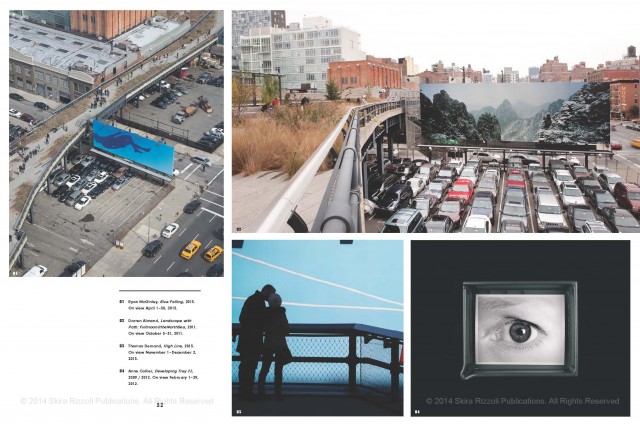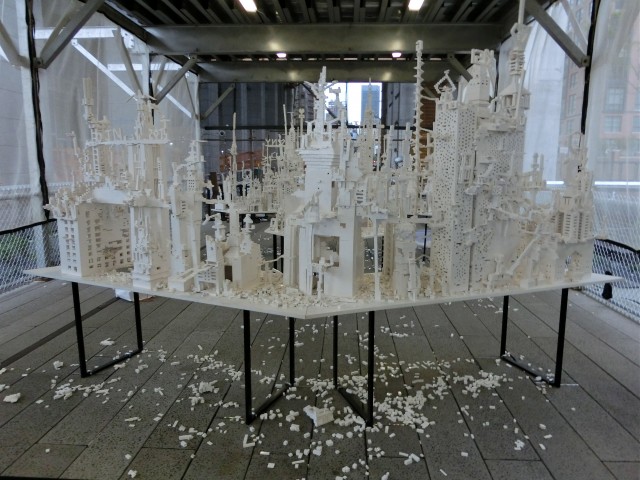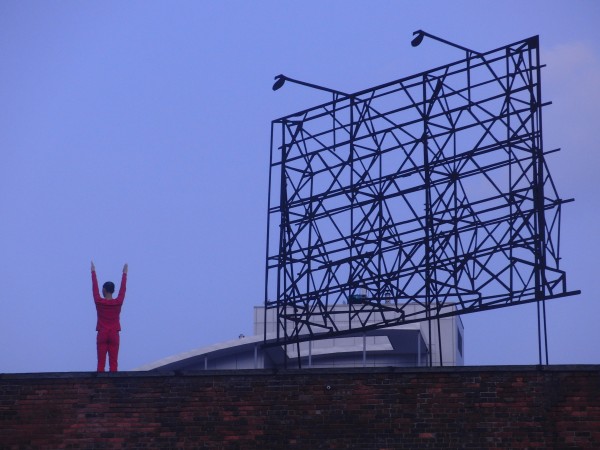
New book HIGH ART: PUBLIC ART ON THE HIGH LINE looks at history of art and performance on repurposed elevated railway
The High Line
Eleventh Ave. from 34th St. to Gansevoort St.
Open daily, free, 7:00 am – 11:00 pm
www.thehighline.org
a walk across the high line, summer 2015
The High Line itself is a glorious work of art. The transformation of the abandoned West Side elevated railway into a public park thirty feet aboveground, weaving from Thirty-Fourth St. and the West Side Highway to Gansevoort St. by near the entrance to the new Whitney, has led to what has deservedly become one of the city’s must-see, most picturesque locations, a place for plants and trees, food and drink, rest and relaxation, and site-specific public art. In her opening essay in the lovely book High Art: Public Art on the High Line (Skira Rizzoli, May 2015, $45), High Line Art curator and director Cecilia Alemani describes the values she has instilled in the art program: “a dedication to bringing important contemporary art to a wide and diverse audience; a desire to surprise viewers with artworks that utilize public channels of communication in new and challenging ways, prompting them to question the role and function of images in public space; and a conviction that artworks are first and foremost sites of encounter and exchange of opinions and experiences.” The full-color book details the history of art on the High Line, which continues to thrillingly achieve Alemani’s goals, from group shows and film screenings to live performances and participatory events — many of which have been covered here on twi-ny — from Sara Sze’s “Still Life with Landscape (Model for a Habitat)” and Stephen Vitiello’s “A Bell for Every Minute” to Trisha Brown Dance Company’s Roof Piece and Alison Knowles’s “Make a Salad.” The large-size paperback also includes a round-table discussion between Alemani and several other curators of public art that takes a fascinating view of how the discipline is changing and how the art is commissioned and perceived. “We want to bring museum-quality works to the High Line and to make them available to our visitors, free of charge,” Alemani tells fellow curators Nicholas Baume, Sara Reisman, Manon Slome, Nato Thompson, and moderator Renaud Proch. “As simple as it sounds, this is a vision that usually resonates with many supporters who share with us a belief in art not only as a form of civic responsibility but also as a basic right that should be equally available to anyone.”

Visitors are invited to contribute to Olafur Eliasson’s “collectivity project” on the High Line (photo by twi-ny/mdr)
The current art on the High Line is representative of Alemani’s mission. Starting on the north side, Adrián Villar Rojas’s “The Evolution of God” (through July 31) comprises thirteen cement and clay blocks that have been slowly breaking apart and disintegrating since September 2014. Embedded at different levels in the blocks, which are just to the inside of the walking path, are such artifacts as sneakers, bones, and clothing, mimicking an architectural dig that is evolving; meanwhile, new growth is popping up in the blocks’ crevices, signaling life among death, like the High Line itself. “Panorama” (through March 2016) consists of works by a dozen artists that meld into and comment on the High Line’s natural and constructed environment. While “The Evolution of God” falls apart, Olafur Eliasson’s “The collectivity project” (through September 30) rises up, two tons of white Lego bricks that visitors are invited to play with, building imaginary cityscapes amid an area that is seeing actual heavy construction all around its perimeters. Gabriel Sierra’s “Untitled (All Branches Are Firewood)” summarizes the growth of the High Line both physically and in the popular aesthetic, comprising bright yellow measuring sticks that could be seen easily in May but have now been nearly completely overgrown by plants and trees. Kris Martin’s “Altar” turns Jan and Hubert van Eyck’s Ghent altarpiece “Adoration of the Mystic Lamb” into a celebration of New York City as a religion unto itself. Ryan Gander’s “To employ the mistress . . . It’s a French toff thing” is a classical-style bust of his wife’s body and upper torso that doubles as a water fountain in which visitors have to try to catch the water as it streams through the air. (Also watch out for Gander’s bronze wallet and cell phone that were left on a bench, as well as a sound piece, “Zooming Out / Toodaloo.”) Damián Ortega’s “Physical Graffiti” is a trio of tags made out of rebar that use the open air, instead of a city train or wall, as a canvas. Andro Wekua’s arched “Window” overlooking Chelsea Piers has now virtually disappeared behind rising plants. You should be able to find your building in Yutaka Sone’s dazzlingly intricate “Little Manhattan New York, New York,” carved in marble. The hardest piece to locate is Katrín Sigurðardóttir’s ecologically minded “Bouvetoya,” a white blob hanging underneath the High Line as you exit by the Whitney, reminiscent of all sorts of things, natural and unnatural, that grow on the undersides of New York structures.

Trisha Brown Dance Company’s “Roof Piece” has been a highlight of the High Line’s innovative performance art programming (photo by twi-ny/mdr)
The High Line has also become home to exciting live performances. Last week, Francisca Benitez’s “As you lean on me and I lean on you, we move forward” combined sign language and improvisation in three chapters in three locations on three different nights. This week Aki Sasamoto’s Food Rental moves into the elevated park, taking place July 21-23 at 7:00 at the Rail Yards by the Thirtieth St. & Eleventh Ave. side. The Japan-born, New York City-based Sasamoto, whose theatrical installation “Strange Attractors” was presented at the 2010 Whitney Biennial, will be serving “micro performances and playful narrative demonstrations” from a specially built food cart, doling out unusual little plays with unexpected sets and props. Admission is free, and no RSVP is required. Afterward, you should check out the latest film screening at High Line Channel 14 in the Fourteenth St. Passage, “Before the GIF,” a series of old-style animation works by Nathalie Djurberg and Hans Berg (I’m a Wild Animal, I’m Saving This Egg for Later), Kota Ezawa (Take Off), Lauren Kelley (True Falsetto), Allison Schulnik (Eager), SUN Hun (Shock of Time, People’s Republic of Zoo), and Keiichi Tanaami (OH! YOKO!). In her High Art essay, “The Seriousness of Play: Performance on the High Line,” Adrienne Edwards writes, “Performance on the High Line is an aleatory collision of chance and unanticipated experiences that is the very pulse of the art form itself. Artists and audiences alike are immersed in the unknown possibilities of the bucolic park and its circumferential stages, which enable encounters in the realm of the swerve, which is to say that performance in this particular vector has a unique, more experimental valence, one in which the artists realize a space of the commons through fleeting structures of social choreography.” Yes, a walk across the High Line itself is like performance art, a social choreography unlike any other in this city filled with public art and social choreography.